Leopard Gecko Setup
This page gives a list of items that you will require to care properly for a leopard gecko. You should have everything well in advance of purchasing your leopard gecko and should have the vivarium running for a few days to ensure that you can provide the correct environment for your leopard gecko. For care information please refer to the short leopard gecko caresheet and the comprehensive leopard gecko caresheet.
This page is copyright of Pauline Smith 2005
 |
 |
||
MAIN SET UP FURNISHINGS FOOD |
 |
||
Vivarium or Tank
The housing can be either a wooden vivarium or an all-glass tank. There are pros and cons to each. Glass tanks are cheaper, easier to keep clean (since they can easily be washed with hot water) and easier to heat with a heat mat (the heat mat can be placed underneath). If opting for a glass tank, do not buy a tall one and ensure that a proper vivarium style hood is used, both of these measures will help with ventilation. The downside to glass tanks is that they cannot be stacked, so take up more room. It is also wise to use a background paper on glass tanks so that the leopard geckos do not feel exposed.
Being terrestrial the tank length is more important than its height. The minimum recommended size for 1 leopard gecko is 2ft (long) x 1.5 x 1.5 ft. A 3ft long tank would be more comfortable for 2 or 3 leopard geckos.
Heat mat and thermostat
Leopard geckos absorb heat through their stomachs, therefore, a heat mat is the best form of heating. The heat mat should be big enough to cover one quarter to one third of the base of the tank. For glass tanks the heat mat can be placed underneath the tank (with an airspace). If you have a wooden viv the heat mat would most likely have to be placed inside the tank.
To ensure that the substrate is heated to the appropriate temperature (88 F) and to keep the mat from overheating, the heat mat should be regulated using a thermostat.
Light / bulbs
Lighting is not essential, however, it is better for the leopard gecko to have a sense of day and night. A consistent day/night cycle is best achieved using a timer. The type (strip, reptile bulb, ordinary low wattage) and placement of the light will depend on the type of vivarium you have, but they should always be out of reach of the gecko or outside the vivarium. (UV lighting is not required, appropriate supplementation should be adequate to provide the necessary vitamins.)
Appropriate bulbs can also be used as the main heat source, however, I firmly believe that heat mats are the most appropriate heat source for leopard geckos and do not use bulbs as a heat source myself, so I wont go into those here, apart from to say if they are used they should be regulated using an appropriate thermostat.
Substrate
Substrate is whatever you choose to line the bottom of your tank with. There are many choices and the substrate debate is a hot topic; one which is guaranteed to cause disagreements between keepers! You should do lots of reading round about substrates to make yourself aware of the risks associated with each type, then make your own decision. DO NOT rely on the what is written on the packaging! remember, the manufacturers are businesses! and in some instances what is written on the packaging is inaccurate.
Most cases of substrate impaction are likely due to inadequate supplementation. If the leopard gecko is deficient in vitamins or minerals, it will purposely eat the substrate, therefore it is essential to provide the correct supplementation. However, substrate can also be swallowed by accident during hunting, which is why large indigestible substrates are not suitable and also why particulate substrates (e.g. sand) should never be deep.
The following is my opinion on substrates (you'll notice it's mostly a list of negative points!!):
- kitchen roll is THE only substrate that should be used for babies and juveniles (their digestive tracts are small and narrow and therefore very vulnerable to substrate impaction). It is suitable for adults too but most people prefer to have a more natural look in their vivarium.
- repti sand (by zoomed) is the substrate I use for my adults. It is a very fine sand. It is, however, quite expensive
- slate tiles or pieces are great! any gaps between the tiles can be filled with sand but these will make your tank very heavy.
- childrens play sand is successfully used by many keepers, my only reservation about play sand is that it clumps (clumping substrates are not great! even though manufacturers will tell you so on the bag!, yes, they may be great for cleaning out BUT it clumps when swallowed too, yes?)
- reptile carpet is available in several types. Some are ok, others are not. Only the non-looped type should be used (as leopard geckos can get their claws stuck in the looped type, resulting in them losing toes). Reptile carpet may also be more difficult to clean
- bark chips, gravel, pebbles, cat litter and other substrates which are totally undigestible are not suitable, these obviously have a very high impaction risk
- calcium sand is not the ideal substrate it is made out to be!. Some varieties are very dusty and may lead to respiratory and/or eye problems. Some (perhaps all) calcium substrates are not digestible, despite what is says on the bag!... in fact, leopard geckos recognise the smell of calcium and will purposely eat the substrate. If the substrate is not digestible this is obviously going to lead to trouble.
- crushed walnut (packaged as Desert Blend) gets a big thumbs down. Firstly it is sharp! and the pieces are quite large. If swallowed, it can irritate and cut the digestive tract and can also cause impaction. It is also great for culturing mould! should it get damp in the vivarium
- corn cob is not digestible (as anyone that eats sweetcorn will know!) and could, therefore, cause impaction. It is also good for culturing mould and bacteria in the tank if it gets wet!
- saw dust is also not suitable as it is dusty and not digestible
Water bowl
Water bowls should be shallow to prevent any accidents. Many types of water bowls are available to buy, alternatively you can use a plant pot base or similar.
Hides
Hides are vital. This is where you leopard gecko will likely spend most of its time. There are a number of different hides available on the market, alternatively you can make your own from a coconut. The best hides are relatively small and very dark (leos seem to prefer squeezing into small dark spaces!).
Humid hide
A humid hide is necessary to help the gecko when it needs to shed its skin. The best way to make one is to cut a corner off the lid of a tupperware container (ensure there are no sharp edges) as an entry hole. Then place an inch or two of moist substrate in there (e.g. moss or vermiculite).
Other decor
You may wish to add other decor to the tank to make it look nice and more interesting for your gecko too. Various types of wood, hides and plastic plants are available from reptile shops (never position anything too high; leos are clumsy climbers and could easily fall off).
Calcium dish
Having a small dish of calcium only powder in the vivarium is a good idea as the leo can help themselves when required. This should lessen the chance of deliberate substrate ingestion. The calcium can be placed in a washed and dried milk carton top or similar tub.
Livefood
A leopard geckos diet should consist of a variety of live insects. Insects that are suitable as staple diets include brown crickets, black crickets, mealworms and silkworms. Cutworms are also available in the UK and may be suitable as a staple diet. As occasional treats you can also offer them waxworms, wax moths, waxworm pupae and pinkies.
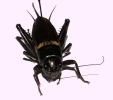 |
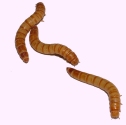 |
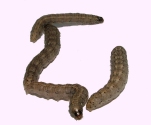 |
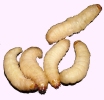 |
 |
 |
Gut load for livefood
This is essential! Gut loading the livefood makes it nutritious for your gecko.. if you don't do this, you are basically feeding your gecko empty containers! (imagine what goodness you'd get from eating only the packaging of your corn flakes!). You can either buy a prepared gutload, or make your own. Fish food flakes are also suitable as a gutload.
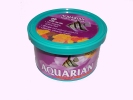 |
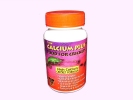 |
Supplements
Supplements are essential too; you should have two types. A calcium & multivitamin powder and a calcium-only powder. The calcium and vitamin powder should be used to dust the livefood once per week. The calcium only powder can be used to dust all other feeds and can also be used in the calcium dish.
 |
 |
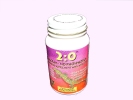 |
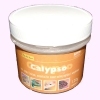 |
Supplements containing vitamins and
calcium |
Calcium only powder |
||
